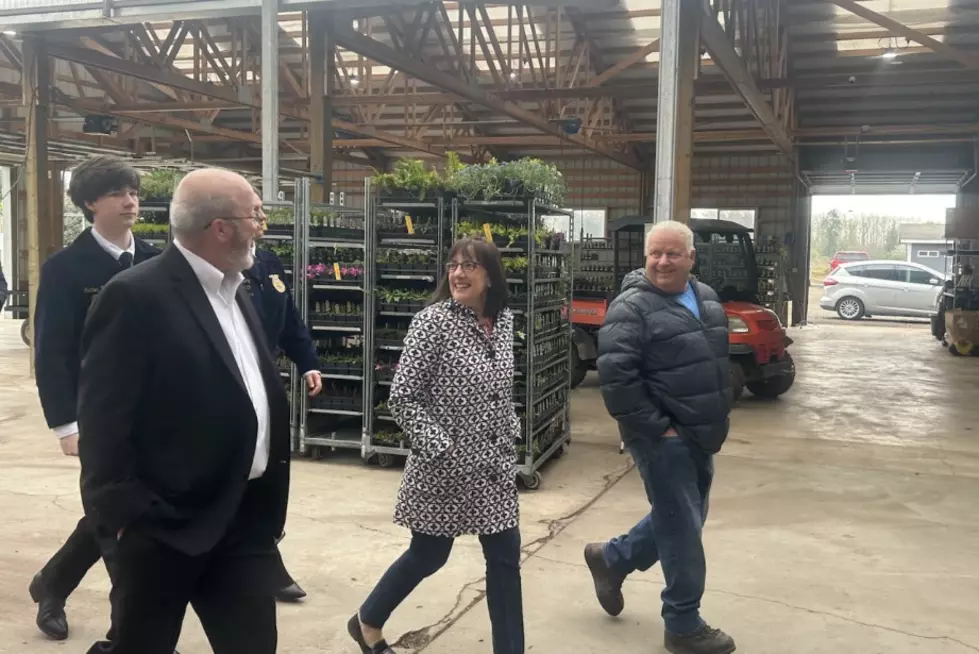
Oregon farmers to talk renewable energy development
Alex Baumhardt
AURORA (Oregon Capital Chronicle) – On the heels of U.S. Rep. Andrea Salinas announcing that five Oregon farms will receive money from the federal government for solar energy projects, other farmers told Salinas and representatives from the U.S. Department of Agriculture that they’ll need more aid to move away from fossil fuels.
Salinas and USDA officials met Friday with about a dozen farmers, electric cooperative utilities managers and rural leaders at Little Prince of Oregon Nursery, a recent grant recipient of USDA’s rural energy grants. The gathering, billed as a discussion about climate resilience and renewable energy, quickly became one about the economics of moving Oregon farms and plant nurseries off fossil fuels for the health of the planet and to save them money while harnessing those farmlands and buildings as sources of renewable energy and extra revenue.
“89% of farms need off-farm income, just to make them make a living,” said Andrew Berke, an administrator for USDA’s Rural Utilities Service who attended the roundtable. “How can we make sure that the farm is the second job, rather than somebody having to go off the farm to get the second job?”
The answer, for many of the farmers present,was to develop renewable energy projects on agricultural land.
Salinas, a Democrat who represents the 6th Congressional District and serves on the House Committee on Agriculture, called the roundtable a “triple-bottom-line kind of discussion.”
“How do we make sure that these growers thrive, that they do have multiple sources of income, and that we’re meeting our climate goals?” she asked.
One way to help, she said, was through five new solar energy projects USDA will fund on farms in Oregon this spring, on top of 38 projects the agency funded last year through its Rural Energy for America Program.
“It is critical to ensure that our rural communities are not only energy efficient, but also equipped with the infrastructure and resources needed to withstand and adapt to the environmental challenges that we know we will all be facing,” she said.
Little Prince of Oregon Nursery previously received $250,000 to begin installing solar panels that will eventually take care of nearly all of the nursery’s electricity needs. Little Prince’s operations manager, Mark Lichty, said eventually they hope to get off of natural gas as a primary energy source entirely.
But others at the roundtable discussed limitations of the USDA grants. It’s difficult for small farms to secure the grant, and farmers struggle to get technical assistance. Others run into a “benefits cliff” that in fact disqualifies many Oregon communities for being slightly too populous. By the USDA’s definition, Baker City in eastern Oregon is too populous to receive rural energy grants and the many farms in and around Woodburn would not qualify for such grants.
Salinas discussed bringing these issues to the House Agriculture Committee as it works to finalize a new farm bill that was supposed to be finished last fall, but was instead given a September 2024 deadline.
Salinas urged Oregon farmers and nursery operators to seek existing grants while ensuring more would come when a farm bill is eventually passed.
John Langdon, a Harrisburg farmer who is trying to establish the state’s first large-scale agrovoltaic farm, asked the federal leaders to invite more farmers to discussions about rural energy policy and to accelerate investments in renewable energy projects on farms and to help with land use conflicts. Langdon’s plan includes putting thousands of solar panels on more than 1,100 acres where crops would also grow and livestock would graze.
“Why are farmers paying for power?” Langdon asked the room, after discussing the potential to generate more than enough solar or wind energy on a farm to not only use but sell. He hopes to move forward on permitting for his solar installation by fall, despite some local opposition.
